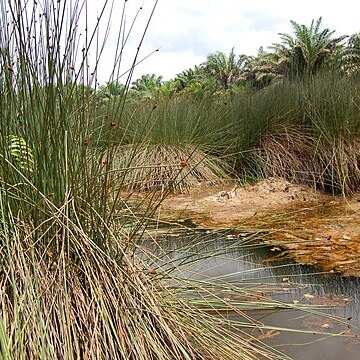Rhizome covered with ovate, acute, striate, ferrugineous scales. Stems approximate, uniseriate on the rhizome, slender, rigid, smooth, grey-green or glaucous, very variable in size, 40-150(-200) cm by 2-5(-8) mm, the septa close together (only visible from outside after drying). Leaf-sheaths stramineous to brownish, the upper one much longer than the lower, 10-30 cm long. Involucral bract terete, very acute, 2-5 cm long. Spikelet ovoid to oblong-ellipsoid, obliquely erect, acute, 1-2(-4) cm by 5-10(-15)mm. Glumes very broadly obovate or suborbicular, very obtuse, often lacerate at the apex, not or hardly hyaline-margined, not keeled, nerveless, shining brown to dark castaneous, 4-6 mm long and about as wide. Flowers as long as or slightly shorter than the glumes. Anthers 2-3 mm long, with dark c. ½ mm long appendage. Nut obovate to sub-orbicular, longitudinally striate, smooth except for the margins scaberulous at the top, brown, 3-4 by 2½-3 mm.
A sedge plant which grows in water. It has underground stems or rhizomes. It keeps growing from year to year. It grows 3 m tall. The stems are almost round, hollow and divided into sections. The leaves are reduced to scales. The flowering shoot is a dense oval spike. It is 3 cm long by 1 cm wide. The glumes or bracts overlap. The spikelets occur singly. The nut is compressed and smooth.

